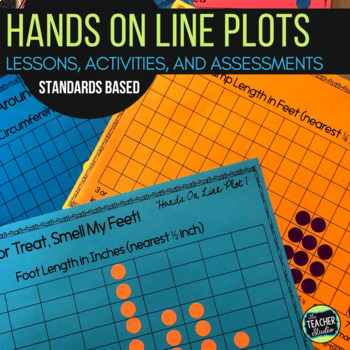Hands On Line Plot Activities, Investigations and Line Plot Assessments
- PDF
What educators are saying
Description
Do you struggle to find quality line plot resources that are fun AND instructional? Line plots are a key part of many sets of math standards for intermediate grades—but many textbooks give very limited opportunities for meaningful math practice with them.
This resource is designed to get students interpreting line plots, making line plots, collecting data, and more! Includes line plots with whole numbers AND line plots with fractions. Line plots actually address so many math concepts--and these activities even make them fun!
My students have a blast with the different activities and really were able to show their math thinking on the practice pages. We had tons of great math talk, and the opportunities for students to really “study” the graphs really helped them construct meaning—not merely fill in the blanks.
This resource is divided into FOUR main sections:
1. “Interpreting Line Plots
This section has 5 different reproducible line plots with questions to help the students think deeply about the data. Each one also has a place for students to generate their OWN questions about the graph—great for class discussions or partner and small group work.
2. “Hands On Line Plots”
This section has 5 hands on “explorations” where students generate data and create class line plots that they then work to study and analyze. Suggestions for use are included as are both customary and metric versions where appropriate.
3. “Making Line Plots”
In this section, students are given 5 different sets of data to use to “plot”—many of which use fractions. Gridded and “open” line plot pages are included so students can either use a preplanned scale or you can work as a class or in small groups to create your own scales that match the data. Question pages are also included to do additional data analysis once the line plots are created.
4. “Assessing Line Plots”
Although any of the other pages could certainly be used as assessments (and these can be used as practice pages), it’s sometimes nice to have a place for students to work independently to “show what they know”. I have included 5 different assessments that ask questions and present data in different ways.
I hope you find it a fun, rigorous, and meaningful way to get your students truly thinking about data and line plots! Selected answers included where applicable. Page count is approximate. The actual document has far more but some are different versions of certain pages.
What are teachers saying?
- "LOVED this resource!! So easy to use as station rotations during our math time, and a great hands-on way to practice line plots and data collection/organization."
- "My students were having trouble understanding line plots. This hands on activity really helped them to make progress and gave them concrete understanding of the skill. I am so glad I bought this!"
- "Amazing scaffolding included! My kids were so engaged and had so much fun! Thank you!"
- "Line plots can be a struggle to teach but this resource has everything you need! Thank you!"
- "WOW, lots of resources here, and lots of fun was had by my students. Thanks!"
---------------------------------------------------------------------------------------
Want to check out a different graphing resource?
GREAT GRAPHS: Constructivist Graph Unit
How about some other measurement resources?
Teaching Tandem: Area and Perimeter
---------------------------------------------------------------------------------------
All rights reserved by ©The Teacher Studio. Purchase of this resource entitles the purchaser the right to reproduce the pages in limited quantities for single classroom use only. Duplication for an entire school, an entire school system, or commercial purposes is strictly forbidden without written permission from the author at fourthgradestudio@gmail.com. Additional licenses are available at a reduced price.





